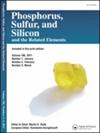利用植硅体粘土去除水介质中的有机磷杀虫剂:多变量优化、非线性动力学建模和热力学研究
IF 1.4
4区 化学
Q4 CHEMISTRY, INORGANIC & NUCLEAR
Phosphorus, Sulfur, and Silicon and the Related Elements
Pub Date : 2024-06-02
DOI:10.1080/10426507.2024.2396443
引用次数: 0
摘要
在我们的生活中,有机磷杀虫剂的过度和不合理使用导致了严重的环境问题,因此有必要提出新颖且具有成本效益的计划,以清除有机磷杀虫剂。本文章由计算机程序翻译,如有差异,请以英文原文为准。
Removal of an organophosphate insecticide from aqueous media using phyllosilicate clay: multivariable optimization, nonlinear kinetic modelling and thermodynamic study
The excessive and irrational use of organophosphate insecticides in our lives has resulted in a serious environmental problem, necessitating the proposal of novel and cost-effective plans to remove these organophosphate insecticides from agricultural or industrial wastewater. In this approach, we investigated the use of phyllosilicate clay as a low-cost and environmentally friendly adsorbent to eliminate an organophosphate insecticide (Diazinon DZN) from an aqueous medium. To achieve an adequate elimination of this insecticide from contaminated water, three main parameters including clay dose () (0.1–1.5 g L−1), medium pH (5–9), and initial DZN concentrations () (55–40 mg L−1) were optimized using a multivariable optimization based on Box-Behnken Design (BBD). The response surface method (RSM) and composite desirability function technique were used to find the ideal conditions for the three input variables and the adsorption amount ( was selected as the output variable. The higher adsorption amount ( was achieved with an adsorbent amount of 1.5 g L−1 in an acidic medium (pH = 5) at room temperature and a Diazinon initial dose of 25.85 mg L−1, with a maximum adsorbent loading of 12.20 mg g−1. The nonlinear modeling study showed that the adsorption kinetics of Diazinon follows the pseudo-second-order model. The thermodynamic study shows that the DZN removal process is exothermic, spontaneous, and of a stable configuration.
求助全文
通过发布文献求助,成功后即可免费获取论文全文。
去求助
来源期刊
CiteScore
2.60
自引率
7.70%
发文量
103
审稿时长
2.1 months
期刊介绍:
Phosphorus, Sulfur, and Silicon and the Related Elements is a monthly publication intended to disseminate current trends and novel methods to those working in the broad and interdisciplinary field of heteroatom chemistry.

 求助内容:
求助内容: 应助结果提醒方式:
应助结果提醒方式:


